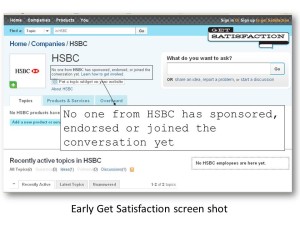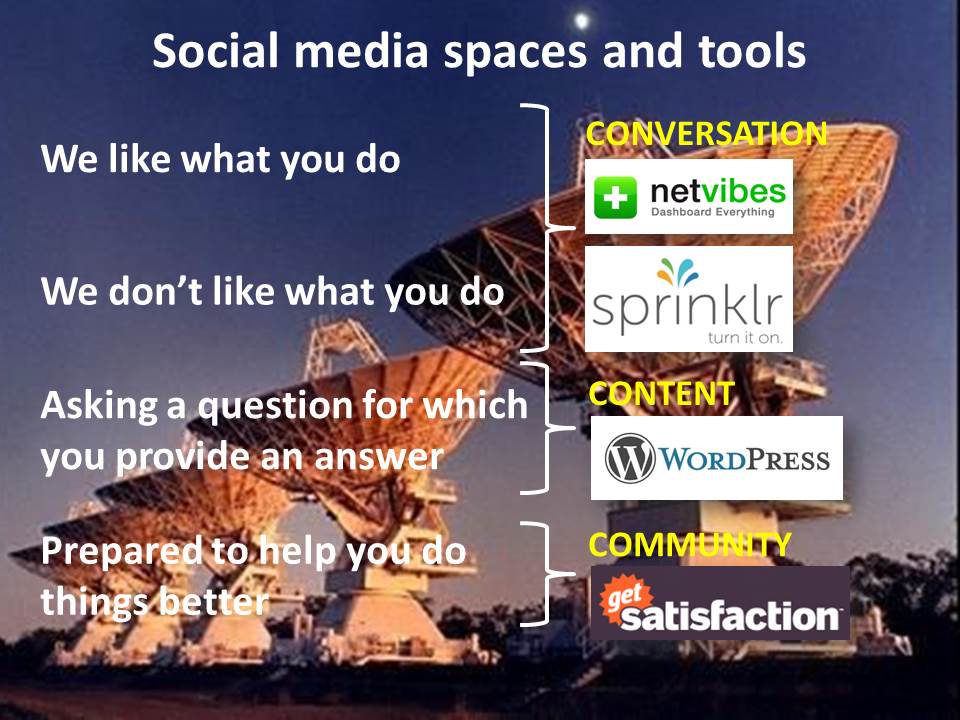I can Get (now) Satisfaction
 In view of my previous post about the three key tools of social media (Sprinklr, WordPress and Get Satisfaction), you can only imagine my own sense of satisfaction – indeed smugness – to see that Sprinklr has just announced it has bought Get Satisfaction.
In view of my previous post about the three key tools of social media (Sprinklr, WordPress and Get Satisfaction), you can only imagine my own sense of satisfaction – indeed smugness – to see that Sprinklr has just announced it has bought Get Satisfaction.
Clearly there are sensible people, with money, out there who think as I do – which is always a reassuring thought.
The interesting thing about Get Satisfaction is that when it first launched it was a customer, rather than a corporate, tool. It was designed to allow customers or consumers to create their own community around the brands they wanted to talk to, or report upon. It was a bit like Trip Advisor – but for any organisation. It was a community owned by the customer to which brands were then invited to join. Indeed for those brands that didn’t join there was a wonderful one-liner “No-one from company X has sponsored, endorsed or joined the conversation yet” which I thought was a great metaphor for the state of social media at the time (notice the usage of the word ‘yet’). I used this in all of my presentations (see pictures) and I was convinced that this marked the dawn of a new era where control of corporate reputation would shift to individual customers operating within structured or semi-structured online communities.
Things haven’t worked out quite like that (yet). Get Satisfaction itself shifted to become a corporate-based product, probably because it’s management decided (sensibly as it turned out) to commercialise first and then build a corporate user base rather than build a big consumer user base and then try to work-out how to commercialise it. However, I think the fact that it started out as a tool for the customer has given it an edge as a customer service tool for brands. It has a recognition that all things start with the customer (rather than the brand) coded into its DNA.
As a brand, if you use a tool like Get Satisfaction you cannot fail but become more connected, in real-time, with your customers. It’s four imperatives – ask a question, report a problem, share an idea, give praise – represent all the things that customers want to base their relationships with brands upon. Creating a customer service community may not be easy because doing it effectively means building a new process which will have tentacles that reach out much further into your business that the traditional marketing, sales and communication processes ever did. It will certainly be harder than simply pumping industrial volumes of content out into the social void. However, it is worth remembering that the easy things to do are not usually the best things to do.
I hope that this acquisition marks an end of the phoney-war of social media – and also an acquisition that cements Sprinklr’s position as the leader in ‘enterpise social media solutions’ (I hate that phrase but you know what I mean). I hope it marks at least the begining of the end of the phase where brands thought they could simply put a ‘social patch’ onto their traditional, audience and content based approaches and then carry on as normal. I hope this marks a growing realisation that brands have to adopt a fundamentally different approach to creating relationships with customers in the social digital space, the world of the individual rather than the world of the audience. A world where brands understand how to harness the power of connection rather than distribution. A world where (as I have said in my ebook) you are successful by not speaking to 97 per cent of your audience – just the three per cent (frequently much less) who, at any given time, want to talk to you.
Or, as I have also said, there are only ten customers critical to your business and social media can help you find them. The only catch being these are the people critical to your business right now, and in 10 minutes time it could be another ten people. I.e. these are the people who, right now, want to ask a question, report a problem, share an idea or give praise.


